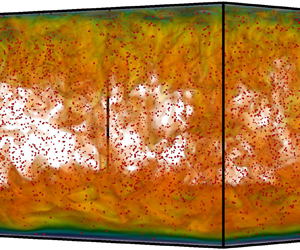Article contents
Wall-bounded thermal turbulent convection driven by heat-releasing point particles
Published online by Cambridge University Press: 15 December 2022
Abstract

In this work we investigate the thermal convection driven by heat-releasing point particles. Three-dimensional direct numerical simulations are conducted for  $1\times 10^7\le {\textit {Ra}} \le 1\times 10^{10}$ and
$1\times 10^7\le {\textit {Ra}} \le 1\times 10^{10}$ and  $0.01\le {\textit {St}} \le 10$, where the Rayleigh number
$0.01\le {\textit {St}} \le 10$, where the Rayleigh number  ${\textit {Ra}}$ and Stokes number
${\textit {Ra}}$ and Stokes number  ${\textit {St}}$ measure the strengths of the heat releasing rate and the Stokes drag, respectively. A regime at intermediate Stokes numbers is identified with most particles accumulating into the top boundary layer region, while for other cases particles are constantly advected over the entire domain. For the latter state, the flow motions are stronger at the upper part of the domain. The thicknesses of both momentum and thermal boundary layers at the top plate follow the same scaling law with
${\textit {St}}$ measure the strengths of the heat releasing rate and the Stokes drag, respectively. A regime at intermediate Stokes numbers is identified with most particles accumulating into the top boundary layer region, while for other cases particles are constantly advected over the entire domain. For the latter state, the flow motions are stronger at the upper part of the domain. The thicknesses of both momentum and thermal boundary layers at the top plate follow the same scaling law with  ${\textit {Ra}}$ and show minor dependences on
${\textit {Ra}}$ and show minor dependences on  ${\textit {St}}$. The volume-averaged temperature and convective flux exhibit non-monotonic variations as
${\textit {St}}$. The volume-averaged temperature and convective flux exhibit non-monotonic variations as  ${\textit {St}}$ increases and reach their minimums at intermediate
${\textit {St}}$ increases and reach their minimums at intermediate  ${\textit {St}}$. The fraction coefficient of heat flux, i.e. the ratio between the heat flux through the bottom plate and the total flux through both plates, shares the similar dependence on
${\textit {St}}$. The fraction coefficient of heat flux, i.e. the ratio between the heat flux through the bottom plate and the total flux through both plates, shares the similar dependence on  ${\textit {St}}$ as the convective flux. The relation between these scaling laws can be explained by using the global balance between the dissipation and convective flux. The scaling laws for the transition between different flow regimes are also proposed and agree with the numerical results. The preferential concentration of particles is observed for all cases and is strongest at intermediate Stokes numbers, for which multiscale clustering emerges with small clusters forming larger ones.
${\textit {St}}$ as the convective flux. The relation between these scaling laws can be explained by using the global balance between the dissipation and convective flux. The scaling laws for the transition between different flow regimes are also proposed and agree with the numerical results. The preferential concentration of particles is observed for all cases and is strongest at intermediate Stokes numbers, for which multiscale clustering emerges with small clusters forming larger ones.
- Type
- JFM Papers
- Information
- Copyright
- © The Author(s), 2022. Published by Cambridge University Press
References
REFERENCES
- 3
- Cited by



